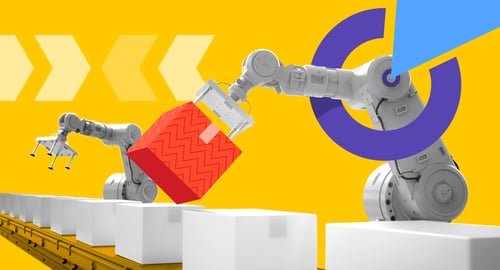The manufacturing industry today operates under demanding conditions to introduce innovations in their product portfolio, reduce the time-to-market of their products, and maintain a successful product line.
However, siloed tools and disjointed processes continue to inhibit growth and obstruct the optimization of manufacturing operations.
In this age of digital manufacturing, people often switch between varied software applications to manufacture a product. It leads to an endless cycle of transferring data from one system to another. Integrating software solutions helps simplify this process and make manufacturing processes more efficient.
In our previous article, we discussed product lifecycle management (PLM), enterprise resource planning (ERP), and quality management systems (QMS) and which type of companies stand to benefit from combining these solutions.
In this article, we will delve deeper into the challenges faced by manufacturing companies and how they can benefit from an optimal combination of software solutions.
Common challenges faced by manufacturing firms
Manufacturing companies face three major challenges regardless of the industry or type of manufacturing.
Bill of materials (BOM) or recipe
What is a BOM?
A bill of materials (BOM) is a comprehensive list of raw materials, parts, assemblies, and their quantities required to produce or repair a product or service. It's often presented hierarchically, with the top level showing finished goods and the lowest level detailing individual parts and items.
PLM systems are used for generating and managing BOMs, as these systems can integrate data from multiple sources and ensure accuracy and consistency in BOM creation. BOMs assist in design and development by facilitating accurate documentation of product specifications and design iterations. BOMs, however, are maintained and used in ERP systems for production and service or maintenance purposes.
There are vast amounts of data associated with different aspects of BOMs. In a non-integrated environment, there are chances of data loss as well as distortion in communication. Engineering and manufacturing teams run the risk of losing out on critical information while working on product design and manufacturing.
Integrating PLM and ERP automates the process of updating and transferring data. It helps in fetching the information—which includes the latest BOM—from the PLM solution and transferring it to the ERP.
Product quality
PLM and QMS utilize the BOM to ensure that products meet these defined quality criteria, enabling organizations to maintain compliance and reliability in their manufacturing processes.
ERP and QMS systems are leveraged to prepare for production and monitor manufacturing operations.
To ensure conformance to quality, it is best advised for QMS systems to work in an integrated setup.
Product cost
Product costs are calculated on the basis of its configuration and the necessary components defined in the PLM system. The costs are then monitored for raw materials and finished products using ERP and financial systems.
Integration of these systems leads to faster time to market and reduced costs while delivering high-quality products.
Using these tools as standalone solutions compromises the uniformity and synchronization of data. This raises the risk of potential errors in manufacturing, which can ultimately result in higher product costs.
How to find the optimal ERP, PLM, QMS mix?
Finding one software solution that provides features of ERP, PLM, and QMS solutions is challenging. Few vendors offer all three, and only a few products include functionality for all.
Furthermore, there are many solutions that focus on a limited number of industries that are part of the manufacturing sector, such as automotive or pharmaceuticals. The table below highlights the manufacturing sectors in the top industries for ERP, PLM, and QMS by number of reviews on G2.
Since there are different products for specific industries, buyers usually have to choose between two options:
- Buy separate solutions, either from the same vendor or from different ones. While combining the three solutions may work, major PLM vendors in the market, such as Dassault Systemes, PTC, and Siemens Digital Industries don't sell ERP systems.
Also, enterprise ERP vendors like Infor, Oracle, and SAP provide both ERP and PLM software, but their ERP offering is more popular among manufacturers compared to their PLM solution.
Finally, ERP and PLM vendors have solutions for QMS, either as part of their primary offering or as a separate product.
- Select ERP with quality management or design functionality. This is a good option for SMB manufacturers making discrete products. Larger manufacturers in complex industries such as pharma or aerospace will likely require two or more separate solutions.
This may also be a good option for a larger company's divisions that make different types of products. For instance, a large industrial equipment manufacturing company will need two or three separate systems—however, one of its divisions that only makes spare parts can use a single solution.
Examples of how companies can benefit from a software mix
Let's look at a few examples of how companies of different sizes from various industries could benefit from using one or multiple solutions.
- A small fashion and apparel company could use one solution that combines ERP, PLM, and QMS features. Some vendors focus exclusively on this industry and create software that covers the entire lifecycle of a fashion and apparel product.
While large fashion manufacturers may need separate PLM software, small companies can use the design features included in most fashion and apparel ERP systems.
These solutions also provide basic quality management functionality, which is usually sufficient for small fashion manufacturers.
- A mid-market aerospace company may need three solutions: ETO ERP, PLM, and QMS. As its products are complex, this company will require a robust PLM solution for design.
When it comes to ERP, typical solutions may not work for this industry, so they will need ETO ERP, which focuses on engineering.
Finally, while ETO ERP usually includes features for quality management, advanced quality control may require standalone QMS software.
- A large food and beverage manufacturer will need Process ERP with PLM features and QMS separately. Process ERP provides functionality specific to this industry, such as recipes, formulas, and batch manufacturing.
This company may not need a standalone PLM solution since food products don't require advanced design features.
It may need a separate QMS software since process ERP solutions may not have advanced quality control features.
What is a good starting point?
It is not imperative for companies to start out with an all-integrated solution.
The trick is to start with a single solution based on business needs. The solution must allow for easy integration with other software in the manufacturing ecosystem.
For instance, if the requirement is to manage product data throughout the product life cycle, the company should opt for a PLM tool. In the future, when there is a need for more robust functionalities such as inventory and work order management, supply chain visibility, management of financial operations, and more, the PLM software should easily integrate with an ERP software that offers all these features.
Many vendors' websites also have a solution marketplace that lists products they integrate with. It is helpful to explore vendor websites to learn about their partner programs. Vendor partnerships help in scaling standalone software and can offer bespoke solutions based on customer requirements.
Ann McGuire, director of product marketing at Arena, a PTC Business, cites that “In today's world, where companies outsource more of their product development and manufacturing processes, it is crucial to provide stakeholders with accurate and up-to-date information. However, sharing product information with global partners without compromising intellectual property can be challenging.“
“The most effective way to ensure that everyone has access to the necessary information is by integrating PLM, ERP, and QMS, which are the backbone of product development, with other systems like CRM and CAD.”
Ann McGuire
Director of Product Marketing, Arena
McGuire continues, "This is one reason why cloud engineering, manufacturing, and quality solutions are gaining market share. Unlike many on-premises integrations, connected cloud-native solutions are secure and reliable. If your product development and manufacturing strategies include outsourcing, your IT evaluations should review the integration strategies of PLM, QMS, and ERP solutions as well as their security capabilities. “
What does the future hold for manufacturing companies?
Artificial intelligence is the new buzzword in the manufacturing industry.
Manufacturing companies are now exploring the power of generative design to transform design processes. Generative design is a subset of artificial intelligence that assists in creating design iterations that help in the development of lightweight products and components, lower manufacturing costs, and streamline operations.
It is a machine learning algorithm that allows a user to input variables such as raw materials, weight, size, budget, and more into the software. The software then presents a variety of possible design options to enable the user to choose a design that suits their requirements.
While some enterprises have begun solving complex engineering challenges and minimizing wastage, small and mid-size companies are yet to explore the endless possibilities generative AI can offer. It is still in its nascent stage and may take a while for industry professionals to experience its full potential.
With advancements in the manufacturing industry, the demand for PLM software is growing. Read about the increasing relevance of PLM software in the manufacturing industry.
 This article is co-written by Gabriel Gheorghiu, G2 research principal, ERP & commerce.
This article is co-written by Gabriel Gheorghiu, G2 research principal, ERP & commerce.
Edited by Sinchana Mistry


 by Anindita Sengupta
by Anindita Sengupta
 by Anindita Sengupta
by Anindita Sengupta
 by Anindita Sengupta
by Anindita Sengupta